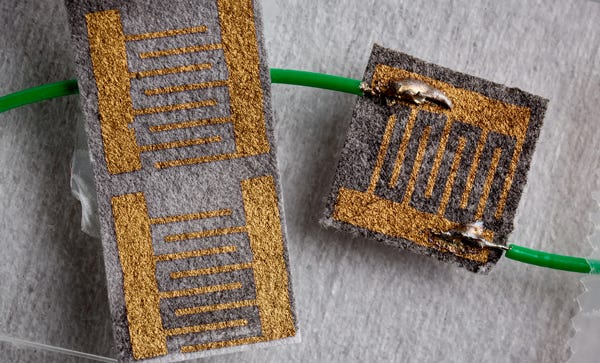Could This New Sensor Help with Eye Injuries?
December 9, 2015
The sensor offers the potential to quickly determine the severity of eye injuries at accident sites and remote areas.
Nancy Crotti
|
The new sensor determines eye injury severity by detecting differences in vitamin C concentration in fluids that leak from the eye. (Image courtesy of L. Brian Stauffer/University of Illinois) |
Researchers at the University of Illinois are working on a portable device that senses vitamin C levels to determine the severity of eye injuries.
The tear film that coats the eye contains low levels of vitamin C, while the interior of the eye holds much higher levels, according to engineering professor Dipanjan Pan, who is working on the device with university medical school ophthalmologist Leanne Labriola.
The device, called OcuCheck, uses graphene platelets layered 1 nm thick on filter paper. Upper layers contain a polymer that interacts with the graphene; gold electrodes; and ascorbate oxidase, an enzyme that binds to ascorbic acid.
"The idea is that the moment that the ascorbic acid comes in and binds to the ascorbate oxidase, it will pull the polymer out of its interaction with the graphene,"and change the sensor's electrical properties, Pan said in a university news release.
The sensor could speed efforts to determine the extent of eye injuries at accident sites, in rural areas lacking ophthalmology specialists or on the battlefield, the university article said. The researchers detailed their work in the journal Scientific Reports.
Currently, people must travel to a hospital to have eye injuries assessed, a process that is often complicated, time-consuming and imprecise, Pan said. OcuCheck could also be used for glaucoma care.
The device would be the first eye injury device to measure ascorbic acid levels, according to Pan and his colleagues. The researchers have tested the device on samples taken from 16 patients who underwent eye surgery and found that their sensor could accurately detect a range of vitamin C levels. They have not yet tested it on trauma patients.
The researchers are working with a university industrial design professor at Illinois to build a handheld, battery-powered device to house the sensor. Pan and Labriola have also founded a company, InnSight Technology, to help them bring the device to market. InnSight Technology has obtained a Phase I Small Business Innovation Research grant from the National Science Foundation, according to the university.
Learn more about cutting-edge medical devices at MD&M West, February 9-11 at the Anaheim Convention Center in Anaheim, CA. |
Nancy Crotti is a contributor to Qmed and MPMN.
Like what you're reading? Subscribe to our daily e-newsletter.
About the Author(s)
You May Also Like



